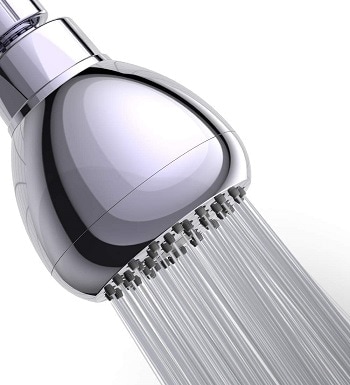2.0 GPM vs 2.5 GPM Shower Head – Which One is Better?
-
Pete Ortiz
- Last updated:

Does your shower feel more like standing under a slow dripping leak than the high-pressure experience you wish for? The problem may be the flow rate of your shower head. When shower water pressure isn’t up to par, it can make showering a less than enjoyable experience. If you’ve ever struggled to rinse the soap from your skin or shampoo from your hair because you just couldn’t get enough water-pressure, then you understand the effects of a low-flow shower head first-hand.
For many homes, the remedy for low water pressure could be as simple as changing to a shower head with a higher rate of flow. Today, 2.0 GPM and 2.5 GPM shower heads tend to be the standard. But how much difference does 0.5 GPM make? Is it worth the cost to switch, and are there any other factors to consider? Let’s break into it and determine whether a 2.5 GPM shower head is superior to a 2.0 GPM model, or possibly the other way around.
What’s the Difference Between 2.0 GPM and 2.5 GPM?
Both of these devices will convert the steady stream of water from your plumbing into a higher-pressure spray that’s more comfortable and useful for washing yourself. But what do the numbers mean? First, you have to understand GPM, which stands for gallons per minute. This is just a measure of how many gallons of water will pass through the shower head in 60 seconds.
A 2.0 GPM shower head will output two gallons of water in a single minute. Likewise, a 2.5 GPM unit will provide 2.5 gallons of water in the same amount of time. While this may not seem like a big difference, over the course of a 15-minute shower, this will add up to 7.5 gallons of water. If three household members shower this much each day, it adds up to a difference of over 150 gallons of water each week, or 600 gallons each month. It adds up quickly!
Government Regulations
2.0 and 2.5 GPM are not arbitrary numbers that manufacturers picked at random for their shower heads. In reality, these are government-imposed restrictions intended to help reduce the amount of water that is wasted in each home. Across the United States, 2.5 GPM is the maximum flow rate allowed for shower heads. That said, some states have even harsher restrictions. In Colorado, New York, and California, 2.0 GPM is the maximum allowed.
Why Choose a 2.5 GPM Shower Head?
The added pressure provided by a 2.5 GPM shower head can make a very noticeable difference in how your shower feels. One of our favorites on the market is the WASSA high-pressure showerhead.
Higher pressure means it’s easier to rinse off the soap. It also feels better on the skin to have the massaging sensation of the high-pressure water. But there are some drawbacks as well. For instance, the extra water you use can have a serious impact on your water bill, as well as the environment. Keep in mind that a shower head with a 2.5 GPM flow rate is actually illegal in some places.
- Higher water pressure
- Better shower experience
- Higher water bills
- Wasteful
Why Choose a 2.0 GPM Shower Head?
While a higher-pressure showerhead may provide a better showering experience, a 2.0 GPM model still has some advantages. The KOHLER Awaken G110 Multifunction Showerhead is one of our favorites this year.
For example, reduced water consumption means a lower water bill and less impact on the environment at large. In some places, 2.0 GPM is the maximum allowable flow. The reduced flow rate is also preferable when a low water supply is a concern, such as in RVs or when you’re using well water. Shower heads with even lower flow rates are also available under the titles of “Eco Performance” or “EP” shower heads.
- Less environmental impact
- Doesn’t waste as much water
- Lower water bill
- Not as easy to rinse off
- Less comfortable showering
Conclusion
On the surface, a difference of 0.5 GPM between shower heads may not seem enough to raise concern. For a family of three, this can add up to over 600 gallons of extra water usage each month. Extrapolated for an entire year, you’re looking at 7,200 extra gallons of water being wasted.
That said, for some people, the improved shower experience is worth the extra cost to their bank account and the environment. Not only does the higher pressure feel better in the shower, but it also makes it easier to get clean and rinse off soap and shampoo. Be aware, that a 2.5 GPM shower head won’t be legal in some areas where you’ll be limited to a 2.0 GPM model maximum.
Featured Image: Chayatorn Laorattanavech, Shutterstock
Contents




